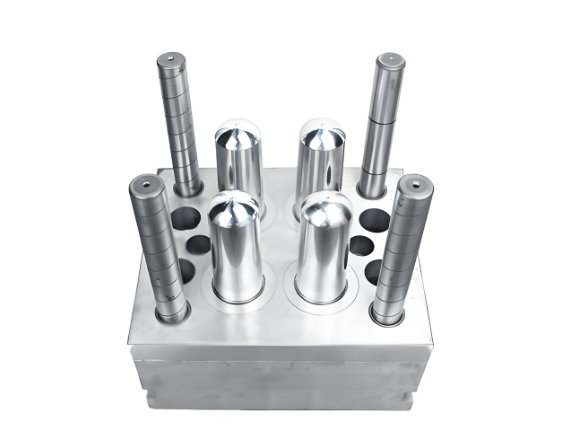
The medical industry is changing fast. Medical injection molding plays a crucial role in producing safe, high-quality devices. Mold makers are developing new techniques to meet industry demands. The future focuses on automation, precision, and sustainability.
1. The Rise of Smart Manufacturing
1.1 AI-Powered Quality Control
- AI detects defects and inconsistencies in real-time.
- Reduces scrap rates and production errors.
- Ensures consistent product quality.
1.2 Machine Learning for Process Optimization
- Predicts mold wear and maintenance needs.
- Adjusts parameters for better efficiency.
- Minimizes downtime and production delays.
1.3 IoT-Enabled Smart Factories
- Sensors track temperature, pressure, and cycle time.
- Allows remote monitoring and data-driven improvements.
- Enhances traceability and regulatory compliance.
2. Advanced Materials for Medical Applications
2.1 Biocompatible Polymers
- Essential for implants, catheters, and surgical tools.
- Withstand sterilization and body fluids.
- Common materials: PEEK, polycarbonate, and silicone.
2.2 Antimicrobial Plastics
- Reduce bacterial growth on medical surfaces.
- Improve infection control in hospitals.
- Used in IV components, tubing, and syringes.
2.3 Sustainable and Recyclable Materials
- Lowers medical plastic waste.
- Meets environmental regulations.
- Industry moves toward biodegradable alternatives.
3. The Expansion of Micro Injection Molding
3.1 Growing Demand for Miniature Components
- Used in pacemakers, drug delivery systems, and biosensors.
- Requires high-precision mold making.
- Ensures tight tolerances for patient safety.
3.2 Overcoming Challenges in Micro-Molding
- Requires advanced cooling and molding systems.
- Materials must maintain strength at micro-scale.
- Mold makers develop ultra-precise tooling.
4. Multi-Material and Overmolding Innovations
4.1 Combining Soft and Hard Plastics
- Improves durability and ergonomics.
- Reduces assembly steps and costs.
- Used in wearable medical devices and surgical grips.
4.2 Applications in Smart Medical Devices
- Enables flexible, soft-touch surfaces.
- Used in heart rate monitors and insulin pumps.
- Enhances comfort and usability.
5. 3D Printing and Hybrid Manufacturing
5.1 Faster Prototyping
- Reduces design and testing time.
- Helps manufacturers create custom medical parts.
- Complements traditional injection molding.
5.2 Combining 3D Printing and Injection Molding
- Hybrid processes allow small-batch customization.
- Useful for personalized implants and prosthetics.
- Lowers production costs for specialized devices.
6. Sustainable Manufacturing Practices
6.1 Energy-Efficient Production
- AI-driven systems reduce energy consumption.
- Smart molding machines use less power.
- Lowers manufacturing costs and carbon footprint.
6.2 Recycling Medical Plastics
- Hospitals demand eco-friendly solutions.
- Companies invest in closed-loop recycling systems.
- Reduces plastic waste from single-use devices.
7. Regulatory Compliance and Traceability
7.1 Stricter FDA and ISO Requirements
- More oversight on material sourcing and production.
- Mold makers must ensure full compliance.
- Automated tracking improves documentation accuracy.
7.2 Blockchain for Supply Chain Transparency
- Tracks raw materials, production, and distribution.
- Prevents counterfeit medical devices.
- Ensures complete traceability and safety.
8. AI and Robotics in Medical Injection Molding
8.1 AI-Driven Process Optimization
- AI predicts mold wear and production errors.
- Machines adjust settings in real-time.
- Reduces material waste and downtime.
8.2 Robotics for Precision Molding
- Automates injection, cooling, and assembly.
- Improves repeatability and consistency.
- Reduces labor costs and production errors.
9. The Role of Digital Twins in Molding
9.1 Virtual Simulations for Process Testing
- Creates virtual copies of the molding process.
- Helps manufacturers test and refine designs.
- Reduces trial-and-error in mold development.
9.2 Predictive Maintenance for Machines
- Detects wear and tear before breakdowns.
- Prevents unexpected downtime.
- Improves overall production efficiency.
10. The Growth of Personalized Medical Devices
10.1 Custom Prosthetics and Implants
- Patient-specific devices improve comfort and function.
- 3D scanning creates accurate mold designs.
- Medical injection molding ensures high-volume production.
10.2 Smart Healthcare Devices
- Wearable sensors track real-time health data.
- Devices become smaller, lighter, and more efficient.
- Custom molding techniques improve design flexibility.
The future of medical injection molding is driven by automation, smart materials, and sustainability. Mold makers play a key role in shaping new medical technologies. As trends evolve, the industry will focus on precision, efficiency, and eco-friendly solutions. The next decade will bring even more advancements, ensuring better healthcare solutions worldwide.
